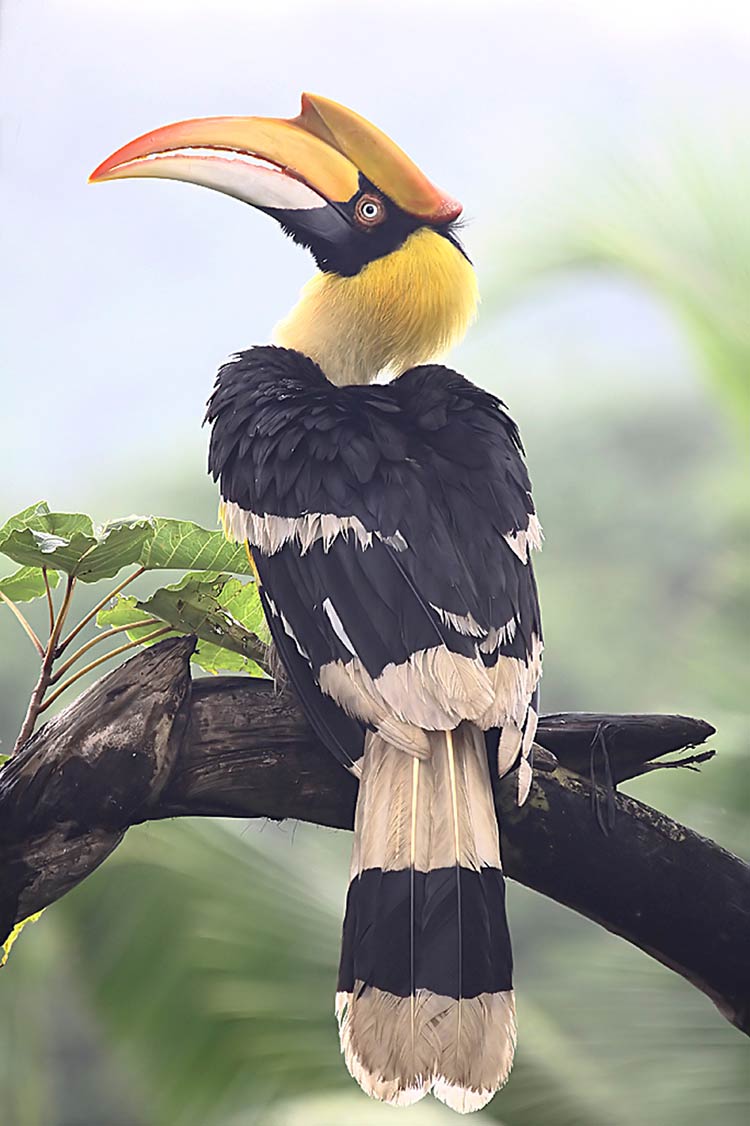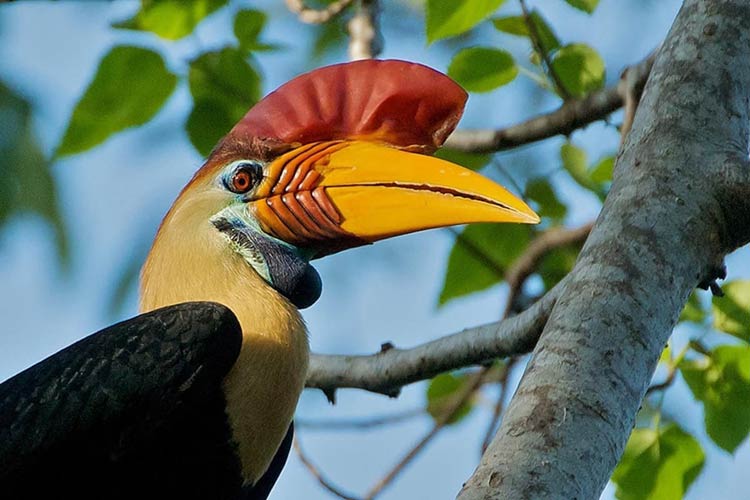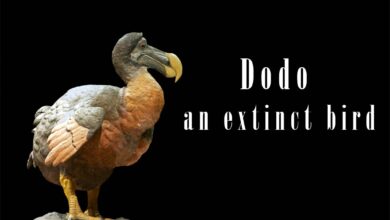Hornbills – Guardians of Forests and Symbol of Beauty
In the dense forests of Asia and Africa, a remarkable bird with a distinctively shaped bill cuts through the canopy with a raucous call that echoes through the trees. Meet the hornbill, a fascinating and charismatic member of the Bucerotidae family. With its striking plumage, unique nesting habits, and crucial role in maintaining the health of tropical ecosystems, the hornbill has captured the imaginations of bird enthusiasts and researchers alike. From its symbiotic relationships with other creatures to its unusual courtship rituals, join us as we delve into the captivating world of the hornbill.
Hornbills are a family of birds known for their striking appearance and unique behaviors. With their distinctive bills, ranging in size from small and slender to large and imposing, hornbills are instantly recognizable. These bills, which are used for everything from catching prey to carving out nesting cavities, are a defining feature of this remarkable bird family.
Hornbills are found in tropical forests throughout Asia and Africa, where they play a crucial role in maintaining the health of these ecosystems. They feed on a wide variety of fruits and insects, and are important seed dispersers, helping to ensure the survival of many plant species. Some species of hornbills also have symbiotic relationships with other creatures, including honeyguides and dwarf mongooses, with whom they share nesting sites.
Hornbills are known for their unusual nesting habits, with many species nesting in tree cavities that are sealed shut with a mixture of mud and regurgitated food. The female is sealed inside the nest cavity for several weeks, during which time she incubates the eggs and is fed by the male through a small opening in the seal. Once the chicks hatch, the female and chicks are released from the nest by the male, who then reseals the cavity until the next breeding season.

Taxonomy
The hornbill family, Bucerotidae, is a diverse group of birds that contains 15 genera and 59 species. These species are found throughout the tropical forests of Asia and Africa, with each species displaying unique characteristics and behaviors that make them fascinating subjects of study for ornithologists and bird enthusiasts alike. Some of the most well-known genera within the Bucerotidae family include Buceros, Tockus, Anthracoceros, and Rhinoplax, each of which contains multiple species that exhibit a range of different physical and behavioral traits. Despite the diversity of the family, all hornbills share several key characteristics, including their distinctive bills and important ecological roles within their respective ecosystems.
Scientific classification
- Kingdom: Animalia
- Phylum: Chordata
- Class: Aves
- Order: Bucerotiformes
- Family: Bucerotidae

Basic Facts About Hornbills
- Hornbills are a family of birds known for their unique bills, which range in size from small and slender to large and imposing.
- There are 59 species of hornbills, which are found throughout the tropical forests of Asia and Africa.
- Hornbills feed on a variety of fruits, insects, and small animals, and are important seed dispersers in their ecosystems.
- Many species of hornbills have unusual nesting habits, with the female sealed inside a cavity while incubating the eggs and being fed by the male through a small opening.
- Hornbills are often brightly colored, with distinctive plumage that varies between species.
- Males are typically larger than females, and sexual dimorphism varies depending on the species.
- The largest species of hornbill is the southern ground hornbill, which can weigh up to 6.3 kg and has a wingspan of about 180 cm.
- Hornbills play important ecological roles in their respective ecosystems, and are considered keystone species in some areas.
- Many species of hornbills are threatened by habitat loss, hunting, and other factors, and conservation efforts are underway to protect these birds and their habitats.
Distribution and habitat
Hornbills are found throughout the tropical forests of Asia and Africa, with each species occupying a specific range within this broader region. The distribution of hornbills is influenced by some factors, including climate, habitat availability, and the presence of other species that compete for resources.
In general, hornbills prefer forested habitats, ranging from lowland rainforests to montane forests and even savannas. Some species are found in primary forests, while others are adapted to more disturbed or fragmented habitats such as secondary forests, plantations, and even urban areas.
Because they rely on forested habitats, many species of hornbills are threatened by deforestation and habitat loss, which are occurring at an alarming rate in many parts of their range. In addition to habitat loss, hornbills are also threatened by hunting, poaching, and the illegal wildlife trade. As a result, conservation efforts are underway to protect hornbill populations and their habitats, with a particular focus on reducing deforestation and improving the management of protected areas.

Characteristics
Appearance
Hornbills are known for their distinctive bills, which are often large, curved, and brightly colored. The shape and size of the bill can vary widely depending on the species, with some species having bills that are long and slender while others have bills that are short and robust.
In addition to their bills, hornbills are often brightly colored, with plumage that can range from black and white to vivid shades of blue, green, and red. Some species have striking crests or casques on their heads, while others have bare skin patches around their eyes or bills.
Hornbills also vary in size, with the smallest species measuring just over 30 cm in length and weighing less than 100 g, while the largest species can weigh up to 6.3 kg and have a wingspan of over 180 cm. Males are typically larger than females, and sexual dimorphism can also be evident in differences in bill size and coloration.
Overall, the appearance of hornbills is highly varied and often striking, making these birds popular subjects of study and admiration for bird enthusiasts and researchers alike.
Size
Hornbills exhibit a wide range of sizes, with the smallest species measuring just over 30 cm (12 inches) in length and weighing less than 100 g (3.5 ounces), while the largest species can weigh up to 6.3 kg (14 pounds) and have a wingspan of over 180 cm (6 feet).
In terms of length, most species of hornbills range between 50-120 cm (20-47 inches) from beak to tail. The smallest species is the black dwarf hornbill (Tockus hartlaubi), which measures just 32 cm (13 inches) in length, while some of the largest species, such as the great hornbill (Buceros bicornis), can measure up to 130 cm (51 inches) in length.
Males are generally larger than females in most hornbill species, though the extent of sexual dimorphism can vary depending on the species and the specific traits being compared. In general, larger body parts such as bills and wings tend to show more sexual dimorphism than smaller body parts.

Why do hornbills have such large beaks?
Hornbills have large beaks for a variety of reasons, including feeding, defense, and communication. Their bills are specially adapted to their feeding habits, which often involve foraging for fruit, insects, and small animals in dense vegetation.
The large, curved bill allows the bird to reach deep into trees and bushes to extract food, and the sharp edges of the bill can be used to cut through tough fruit and prey. Some species of hornbills also use their bills to catch flying insects or to probe for insects hiding in bark or soil.
Hornbills also use their bills for defense, particularly against predators such as snakes and birds of prey. Their bills are powerful enough to break branches and even to fend off predators that are larger than themselves.
Finally, hornbills use their bills as a form of communication. Some species of hornbills have specialized vocalizations that are produced using their bills, and they may also use their bills to create loud drumming sounds to signal their presence to other birds.
Overall, the large bill is a critical adaptation that allows hornbills to survive in their unique habitat and to carry out important functions such as feeding, defense, and communication.
Behavior, Lifestyle and Ecology
Hornbills are social birds that typically live in pairs or small groups within their territories. Many species of hornbills exhibit strong mate fidelity, meaning that they form long-lasting bonds with their partners and often engage in elaborate courtship behaviors to attract a mate.
Hornbills are primarily arboreal and spend most of their time in the forest canopy, where they forage for fruits, insects, small animals, and other food items. They are important seed dispersers and play a key role in maintaining the health and diversity of tropical forest ecosystems.
Hornbills are also known for their unique breeding behavior, which involves the female sealing herself inside a tree cavity or nest chamber using a combination of mud, droppings, and other materials. The male will then deliver food to the female and their chicks through a narrow opening in the seal, providing protection and support until the chicks are ready to fledge.
In addition to their important ecological roles, hornbills are also culturally significant in many parts of their range, with some species considered sacred or associated with local myths and legends. However, many species of hornbills are threatened by habitat loss, hunting, and other human activities, making conservation efforts critical to their long-term survival.

Diet
Hornbills have a varied diet that includes fruits, insects, small animals, and other food items depending on the species and the availability of food in their habitat. Some species are primarily frugivorous, meaning that they feed on fruits and berries, while others are more carnivorous and feed on insects, small reptiles, and other animals.
Fruit is a particularly important food source for many species of hornbills, and they are known for their role as important seed dispersers in tropical forest ecosystems. Hornbills have large bills that are well-adapted for grasping and carrying fruits, and they are able to swallow fruits whole or break them into smaller pieces with their bills.
In addition to fruit, many species of hornbills also feed on insects and other small animals. They use their bills to catch and crush insects and other prey, and they are able to digest the tough exoskeletons of insects and other invertebrates.
Overall, hornbills are important members of many tropical forest ecosystems, playing key roles as seed dispersers and predators of insects and other small animals. However, habitat loss and other threats are putting many species at risk, highlighting the need for conservation efforts to protect these important birds and their habitats.
Reproduction and parenting
Hornbills have unique breeding behavior that involves the female sealing herself inside a tree cavity or nest chamber using a combination of mud, droppings, and other materials. The male will then deliver food to the female and their chicks through a narrow opening in the seal, providing protection and support until the chicks are ready to fledge.
Once a pair of hornbills has formed a bond, they will typically mate for life and defend a territory together. During the breeding season, the female will lay a clutch of one to six eggs inside the sealed nest chamber, where she will incubate them for several weeks.
After the chicks hatch, the female will remain inside the nest chamber with them while the male brings food to the nest. The male will feed the female and chicks through a narrow opening in the seal, providing a steady supply of food to support their growth and development.
As the chicks grow, they will eventually break through the seal and emerge from the nest chamber. The parents will continue to feed and care for the chicks for several months, teaching them how to forage for food and defend themselves against predators.

Predators and Threats
Hornbills face a variety of threats to their survival, including habitat loss, hunting, and predation. As many species of hornbills rely on large trees for nesting and feeding, deforestation and habitat fragmentation are major threats to their populations. Habitat loss also leads to a decline in food availability and can increase competition with other animals.
Hornbills are also hunted for their meat and for their bills, which are used in traditional medicine and as decorative items. In some areas, hunting pressure is so intense that hornbill populations have been severely depleted or eliminated altogether.
Predation is also a threat to hornbills, particularly their eggs and chicks, which are vulnerable to a range of predators including monkeys, snakes, and birds of prey. Adult hornbills are less vulnerable to predation due to their large size and powerful bills, which can be used to defend against predators.
Overall, habitat loss, hunting, and predation are major threats to the survival of many species of hornbills. Conservation efforts, including the protection of critical habitat, the establishment of protected areas, and efforts to reduce hunting and poaching, are critical to the long-term survival of these important birds.
Interactions with humans
Hornbills have a long history of interaction with humans, both positive and negative. In many cultures, these birds are revered as symbols of strength, wisdom, and good fortune, and they have been featured in art and mythology for thousands of years.
However, hornbills are also hunted for their meat, their bills, and their feathers, and their populations have been threatened by habitat loss and fragmentation due to human activities such as logging, agriculture, and urbanization.
Conservation efforts are underway to protect hornbill populations and their habitat, and many local communities are actively involved in these efforts. In some areas, ecotourism programs have been established that allow visitors to observe hornbills in the wild, providing a sustainable source of income for local communities and raising awareness of the importance of conserving these remarkable birds.
Overall, the relationship between humans and hornbills is complex, and efforts are needed to ensure that these birds are protected and conserved for future generations to enjoy.

Population
The population of hornbills varies by species and region, with some species having healthy populations while others are endangered or critically endangered. Habitat loss and fragmentation due to human activities such as logging, agriculture, and urbanization are major threats to hornbill populations, particularly in Southeast Asia and Africa.
In addition to habitat loss, hornbills are also hunted for their meat, their bills, and their feathers, and this has contributed to declines in some populations. Climate change is also expected to have an impact on hornbill populations, particularly those that are specialized to certain habitats or foods.
Conservation efforts are underway to protect hornbill populations and their habitat, including habitat restoration, anti-poaching measures, and community-based conservation initiatives. However, these efforts require sustained funding and commitment in order to be successful.
Status and conservation
Many species of hornbills are threatened with extinction due to habitat loss, hunting, and other human activities. According to the International Union for Conservation of Nature (IUCN), several species are listed as endangered, critically endangered, or vulnerable, including the helmeted hornbill, the great hornbill, the Rufous-necked hornbill, and the Narcondam hornbill, among others.
Conservation efforts are underway to protect hornbill populations and their habitats, including habitat restoration, anti-poaching measures, and community-based conservation initiatives. These efforts often involve partnerships between conservation organizations, governments, and local communities, and may include ecotourism programs and awareness-raising campaigns.
One major threat to hornbills is the illegal trade in their beaks, which are prized in some cultures for their supposed medicinal properties and as a luxury item. This has led to a significant decline in some hornbill populations, particularly the helmeted hornbill in Southeast Asia. Efforts are underway to combat this trade, including increased law enforcement and awareness-raising campaigns.

Hornbills in numbers / dimensions
- Black dwarf hornbill (Tockus hartlaubi): 99.1 g (3.5 oz), 32 cm (12.6 in) in length
- Southern ground hornbill (Bucorvus leadbeateri): average weight of 3.77 kg (8.3 lb), can weigh up to 6.3 kg (14 lb), wingspan about 180 cm (5.9 ft)
- Abyssinian ground hornbill (Bucorvus abyssinicus): up to about 130 cm (4.3 ft) in length
- Great hornbill (Buceros bicornis): up to about 130 cm (4.3 ft) in length
- Helmeted hornbill (Rhinoplax vigil): probably the longest of all (perhaps exceeding 150 cm (4.9 ft)) thanks in part to its extended tail feathers.
Hornbills in culture
Hornbills have been important in the cultures and traditions of many societies throughout their range. In some African cultures, the Southern ground hornbill is considered to be a messenger of the gods, and is revered and protected as a result. In parts of Asia, the Helmeted hornbill is considered a symbol of good luck and prosperity, and its casque (beak) has been used in traditional medicine and as a decorative item for centuries.
Hornbills have also been featured in art and literature. For example, in African folk tales, the hornbill is often portrayed as a clever and mischievous character, while in the novel “Things Fall Apart” by Chinua Achebe, the hornbill is used as a metaphor for change and transformation.
In modern culture, hornbills have been featured in documentaries and wildlife films, such as the BBC’s “Natural World” series, as well as in zoos and other wildlife parks around the world. Overall, hornbills continue to captivate people with their unique appearance, behavior, and cultural significance.

Hornbills in movies
Hornbills have appeared in many movies and documentaries over the years, often as part of the natural environment or as a representation of the local culture. For example, in the Disney animated movie “The Lion King,” Zazu, the red-billed hornbill, serves as a major character and advisor to the king. In the movie “Ace Ventura: When Nature Calls,” the African grey hornbill is featured in a memorable scene where Ace helps to deliver its egg.
Hornbills have also been featured in documentaries, such as “The Life of Birds” by David Attenborough, which highlights the incredible nesting habits of the hornbill. Other documentaries, such as “Hornbills: Faking It” and “Hornbills: Partners for Life,” showcase the unique behaviors and ecological roles of different species of hornbills.
Overall, hornbills have played a small but memorable role in various films and documentaries, helping to raise awareness and appreciation for these fascinating birds.
Associations with other species
Hornbills have various associations with other species in their ecosystem. They are often involved in mutualistic relationships with certain plants and animals, such as figs, which they help to disperse through their diet and excretion. Some species of hornbills also form associations with other birds, such as the African grey hornbill, which nests in abandoned woodpecker holes alongside barbets and other species.
In addition, hornbills are preyed upon by a variety of predators, including eagles, large snakes, and humans, and their presence in the environment can serve as an indicator of ecosystem health and stability. Overall, hornbills are an important part of many different ecological communities and play a vital role in maintaining the balance of these ecosystems.

Interesting facts about Hornbills
- Hornbills have a unique nesting behavior, with the female sealing herself inside the nest cavity using a mixture of mud, droppings, and food, leaving only a narrow slit for the male to pass food through. This helps to protect the female and chicks from predators.
- The casque, or enlarged beak structure, of hornbills is not just for show. It also serves as a resonating chamber that amplifies the bird’s calls, helping it to communicate over long distances.
- Some species of hornbills are known to form monogamous pairs that mate for life, while others are polygynous, with males mating with multiple females.
- Hornbills are important seed dispersers in their ecosystems, with some species known to disperse the seeds of over 100 different plant species.
- The largest species of hornbill, the Southern ground hornbill, has a wingspan of up to 180 cm and is capable of flight speeds of up to 60 km/h.
- In some cultures, hornbills are considered to be symbols of good luck or protectors of the forest.
- The helmeted hornbill, found in Southeast Asia, has a highly prized casque that has led to widespread poaching and habitat loss, making it one of the most endangered hornbill species in the world.
- Hornbills have a unique digestive system that allows them to break down tough fibrous plant materials, making them important seed dispersers in their ecosystems.
- Some species of hornbills have a close relationship with fig trees, with both the birds and the trees depending on each other for survival.
- Hornbills are known for their unique flying abilities, including the ability to fly upside down and backwards, and to make tight turns while flying at high speeds.

Q&A (questions and answers) about Hornbills
Q: What is a hornbill?
A: A hornbill is a type of bird that belongs to the family Bucerotidae, characterized by their large beaks or casques.
Q: Where are hornbills found?
A: Hornbills are found in tropical and subtropical forests in Africa, Asia, and Melanesia.
Q: What do hornbills eat?
A: Hornbills are omnivorous and eat a variety of foods, including fruits, insects, small mammals, and reptiles.
Q: How do hornbills reproduce?
A: Hornbills reproduce by laying eggs in a nest cavity, with the female sealing herself inside while incubating the eggs and caring for the chicks.
Q: How long do hornbills live?
A: The lifespan of hornbills varies depending on the species, but they typically live for 20 to 30 years in the wild.
Q: Why do hornbills have large beaks?
A: Hornbills have large beaks for a variety of reasons, including finding and capturing prey, defense, and communication.
Q: Are hornbills endangered?
A: Many species of hornbills are threatened or endangered due to habitat loss and hunting for their meat, casques, and feathers.
Q: How do hornbills communicate?
A: Hornbills communicate using a variety of calls, including territorial calls, mating calls, and alarm calls.
Q: Do hornbills migrate?
A: Some species of hornbills are migratory, while others are sedentary and do not migrate.
Q: What is the largest species of hornbill?
A: The Southern ground hornbill is the largest species of hornbill, with a wingspan of up to 180 cm and an average weight of 3.77 kg.



















